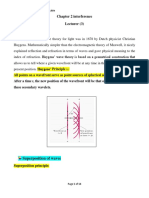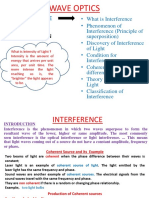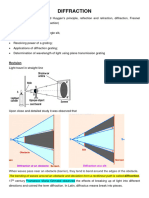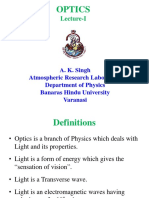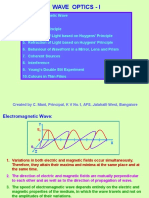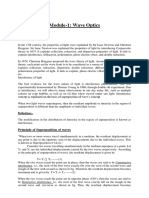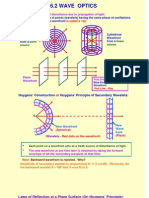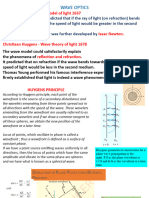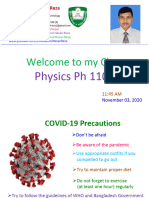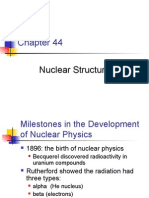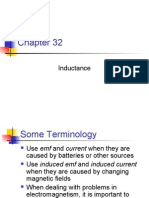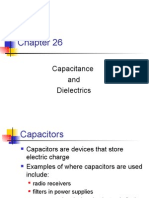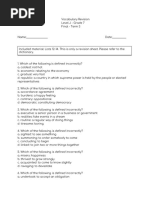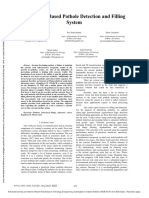0 ratings0% found this document useful (0 votes)
442 viewsPC Chapter 37
PC Chapter 37
Uploaded by
ultimuThis document discusses interference of light waves using Young's double-slit experiment. It explains that interference occurs when light waves from two coherent sources combine. In Young's experiment, light passing through two slits produces a pattern of bright and dark fringes on a screen due to constructive and destructive interference. The position of the fringes can be calculated based on the path difference between waves from each slit. Phasor diagrams provide another way to understand the combination of waves and resulting interference patterns.
Copyright:
Attribution Non-Commercial (BY-NC)
Available Formats
Download as PPT, PDF, TXT or read online from Scribd
PC Chapter 37
PC Chapter 37
Uploaded by
ultimu0 ratings0% found this document useful (0 votes)
442 views68 pagesThis document discusses interference of light waves using Young's double-slit experiment. It explains that interference occurs when light waves from two coherent sources combine. In Young's experiment, light passing through two slits produces a pattern of bright and dark fringes on a screen due to constructive and destructive interference. The position of the fringes can be calculated based on the path difference between waves from each slit. Phasor diagrams provide another way to understand the combination of waves and resulting interference patterns.
Copyright
© Attribution Non-Commercial (BY-NC)
Available Formats
PPT, PDF, TXT or read online from Scribd
Share this document
Did you find this document useful?
Is this content inappropriate?
This document discusses interference of light waves using Young's double-slit experiment. It explains that interference occurs when light waves from two coherent sources combine. In Young's experiment, light passing through two slits produces a pattern of bright and dark fringes on a screen due to constructive and destructive interference. The position of the fringes can be calculated based on the path difference between waves from each slit. Phasor diagrams provide another way to understand the combination of waves and resulting interference patterns.
Copyright:
Attribution Non-Commercial (BY-NC)
Available Formats
Download as PPT, PDF, TXT or read online from Scribd
Download as ppt, pdf, or txt
0 ratings0% found this document useful (0 votes)
442 views68 pagesPC Chapter 37
PC Chapter 37
Uploaded by
ultimuThis document discusses interference of light waves using Young's double-slit experiment. It explains that interference occurs when light waves from two coherent sources combine. In Young's experiment, light passing through two slits produces a pattern of bright and dark fringes on a screen due to constructive and destructive interference. The position of the fringes can be calculated based on the path difference between waves from each slit. Phasor diagrams provide another way to understand the combination of waves and resulting interference patterns.
Copyright:
Attribution Non-Commercial (BY-NC)
Available Formats
Download as PPT, PDF, TXT or read online from Scribd
Download as ppt, pdf, or txt
You are on page 1of 68
Chapter 37
Interference of Light Waves
Wave Optics
Wave optics is a study concerned with
phenomena that cannot be adequately
explained by geometric (ray) optics
These phenomena include:
Interference
Diffraction
Polarization
Interference
In constructive interference the amplitude of
the resultant wave is greater than that of
either individual wave
In destructive interference the amplitude of
the resultant wave is less than that of either
individual wave
All interference associated with light waves
arises when the electromagnetic fields that
constitute the individual waves combine
Conditions for Interference
To observe interference in light waves,
the following two conditions must be
met:
1) The sources must be coherent
They must maintain a constant phase with
respect to each other
2) The sources should be monochromatic
Monochromatic means they have a single
wavelength
Producing Coherent Sources
Light from a monochromatic source is
used to illuminate a barrier
The barrier contains two narrow slits
The slits are small openings
The light emerging from the two slits is
coherent since a single source
produces the original light beam
This is a commonly used method
Diffraction
From Huygens’s
principle we know
the waves spread
out from the slits
This divergence of
light from its initial
line of travel is
called diffraction
Young’s Double-Slit
Experiment: Schematic
Thomas Young first
demonstrated interference
in light waves from two
sources in 1801
The narrow slits S1 and S2
act as sources of waves
The waves emerging from
the slits originate from the
same wave front and
therefore are always in
phase
Resulting Interference Pattern
The light from the two slits
forms a visible pattern on a
screen
The pattern consists of a
series of bright and dark
parallel bands called fringes
Constructive interference
occurs where a bright fringe
occurs
Destructive interference
results in a dark fringe
Active Figure 37.2
(SLIDESHOW MODE ONLY)
Interference Patterns
Constructive interference
occurs at point P
The two waves travel the
same distance
Therefore, they arrive in
phase
As a result, constructive
interference occurs at this
point and a bright fringe is
observed
Interference Patterns, 2
The upper wave has
to travel farther than
the lower wave to
reach point Q
The upper wave
travels one
wavelength farther
Therefore, the waves
arrive in phase
A second bright fringe
occurs at this position
Interference Patterns, 3
The upper wave travels
one-half of a
wavelength farther than
the lower wave to reach
point R
The trough of the
bottom wave overlaps
the crest of the upper
wave
This is destructive
interference
A dark fringe occurs
Young’s Double-Slit
Experiment: Geometry
The path difference, δ,
is found from the tan
triangle
δ = r2 – r1 = d sin θ
This assumes the paths
are parallel
Not exactly true, but a
very good approximation
if L is much greater than
d
Interference Equations
For a bright fringe produced by constructive
interference, the path difference must be
either zero or some integral multiple of the
wavelength
δ = d sin θ bright = mλ
m = 0, ±1, ±2, …
m is called the order number
When m = 0, it is the zeroth-order maximum
When m = ±1, it is called the first-order maximum
Interference Equations, 2
When destructive interference occurs, a
dark fringe is observed
This needs a path difference of an odd
half wavelength
δ = d sin θdark = (m + ½)λ
m = 0, ±1, ±2, …
Interference Equations, 4
The positions of the fringes can be measured
vertically from the zeroth-order maximum
Assumptions
L >> d
d >> λ
Approximation:
θ is small and therefore the small angle
approximation tan θ ~ sin θ can be used
y = L tan θ ≈ L sin θ
Interference Equations, final
For bright fringes
λL
y bright m (m 0 , 1, 2 K )
d
For dark fringes
λL 1
y dark m (m 0 , 1, 2 K )
d 2
Uses for Young’s Double-Slit
Experiment
Young’s double-slit experiment provides
a method for measuring wavelength of
the light
This experiment gave the wave model
of light a great deal of credibility
It was inconceivable that particles of light
could cancel each other in a way that
would explain the dark fringes
Intensity Distribution: Double-
Slit Interference Pattern
The bright fringes in the interference
pattern do not have sharp edges
The equations developed give the location
of only the centers of the bright and dark
fringes
We can calculate the distribution of light
intensity associated with the double-slit
interference pattern
Intensity Distribution,
Assumptions
Assumptions:
The two slits represent coherent sources of
sinusoidal waves
The waves from the slits have the same angular
frequency, ω
The waves have a constant phase difference, φ
The total magnitude of the electric field at
any point on the screen is the
superposition of the two waves
Intensity Distribution,
Electric Fields
The magnitude of
each wave at point
P can be found
E1 = Eo sin ωt
E2 = Eo sin (ωt + φ)
Both waves have the
same amplitude, Eo
Intensity Distribution,
Phase Relationships
The phase difference between the two waves
at P depends on their path difference
= r2 – r1 = d sin θ
A path difference of λ corresponds to a phase
difference of 2π rad
A path difference of is the same fraction of λ
as the phase difference φ is of 2π
This gives φ 2π δ 2π d sin θ
λ λ
Intensity Distribution,
Resultant Field
The magnitude of the resultant electric field
comes from the superposition principle
EP = E1+ E2 = Eo[sin ωt + sin (ωt + φ)]
This can also be expressed as
φ φ
EP 2Eωt
o cos sin
2 2
EP has the same frequency as the light at the slits
The magnitude of the field is multiplied by the
factor 2 cos (φ / 2)
Intensity Distribution, Equation
The expression for the intensity comes
from the fact that the intensity of a wave
is proportional to the square of the
resultant electric field magnitude at that
point
The intensity therefore is
πd sin θ 2 πd
I I max cos
2
I max cos y
λ λL
Light Intensity, Graph
The interference
pattern consists of
equally spaced
fringes of equal
intensity
This result is valid
only if L >> d and for
small values of θ
Phasor Addition of Waves, E1
The sinusoidal wave can
be represented
graphically by a phasor of
magnitude Eo rotating
about the origin
counterclockwise with an
angular frequency ω
E1 = Eo sin ωt
It makes an angle of ωt with
the horizontal axis
E1 is the projection on the
vertical axis
Phasor Addition of Waves, E2
The second
sinusoidal wave is
E2 = Eo sin (ωt + φ)
It has the same
amplitude and
frequency as E1
Its phase is φ with
respect to E1
Phasor Addition of Waves, ER
The resultant is the
sum of E1 and E2
ER rotates with the
same angular
frequency ω
The projection of ER
along the vertical axis
equals the sum of the
projections of the
other two vectors
ER at a Given Time
From geometry at t = 0,
ER = 2E0 cos α = 2Eo cos
(φ / 2)
The projection of ER
along the vertical axis at
any time t is
φ
EP Eωt
R sin
2
φ φ
2Eωt
o cos sin
2 2
Finding the Resultant of
Several Waves
Represent the
waves by phasors
Remember to
maintain the proper
phase relationship
between one phasor
and the next
The resultant phasor
ER is the vector sum
of the individual
phasors
Finding the Resultant of
Several Waves, cont.
At each instant, the projection of ER
along the vertical axis represents the
time variation of the resultant wave
The phase angle α is between ER and
the first phasor
The resultant is given by the expression
EP = ER sin (ωt + φ)
Phasor Diagrams for Two
Coherent Sources, Comments
ER is a maximum at φ = 0, 2π, 4π, …
The intensity is also a maximum at these
points
ER is zero at φ = π, 3π, …
The intensity is also zero at these points
These results agree with the results
obtained from other procedures
Phasor Diagrams for Two
Coherent Sources, Diagrams
Three-Slit Interference Pattern
Assume three equally spaced slits
The fields are:
E1 = Eo sin ωt
E2 = Eo sin (ωt + φ)
E3 = Eo sin (ωt + 2φ)
Phasor diagrams can be used to find
the resultant magnitude of the electric
field
Active Figure 37.11
(SLIDESHOW MODE ONLY)
Three Slits – Phasor Diagram
The phasor diagram
shows the electric field
components and the
resultant field
The field at P has a
maximum value of 3Eo
at φ = 0, ±2 , ± 4 ...
These points are called
primary maxima
Three Slits, Additional Maxima
The primary maxima occur when the
phasors are in the same direction
Secondary maxima occur when the
wave from one slit exactly cancels the
wave from another slit
The field at P has a value of Eo
These points occur at φ = 0, ± , ±3 ...
Three Slits, Minima
Total destructive interference occurs
when the wave from all the slits form a
closed triangle
The field at P has a value of 0
These points occur at φ = 0, ±2 /3, ±4 /3
...
Three Slits, Phasor Diagrams
Three Slits, Intensity Graphs
The primary maxima
are nine times more
intense than the
secondary maxima
The intensity varies
as ER2
For N slits, the
primary maxima is
N2 times greater
than that due to a
single slit
Active Figure 37.13
(SLIDESHOW MODE ONLY)
Three Slits, Final Comments
As the number of slits increases, the primary
maxima increase in intensity and become
narrower
As the number of slits increases, the
secondary maxima decrease in intensity with
respect to the primary maxima
As the number of slits increases, the number
of secondary maxima also increases
The number of secondary maxima is always
N - 2 where N is the number of slits
Lloyd’s Mirror
An arrangement for
producing an interference
pattern with a single light
source
Waves reach point P
either by a direct path or
by reflection
The reflected ray can be
treated as a ray from the
source S’ behind the
mirror
Interference Pattern from a
Lloyd’s Mirror
This arrangement can be thought of as a
double-slit source with the distance between
points S and S’ comparable to length d
An interference pattern is formed
The positions of the dark and bright fringes
are reversed relative to the pattern of two real
sources
This is because there is a 180° phase change
produced by the reflection
Phase Changes Due To
Reflection
An electromagnetic
wave undergoes a
phase change of 180°
upon reflection from a
medium of higher index
of refraction than the
one in which it was
traveling
Analogous to a pulse
on a string reflected
from a rigid support
Phase Changes Due To
Reflection, cont.
There is no phase
change when the
wave is reflected
from a boundary
leading to a
medium of lower
index of refraction
Analogous to a
pulse on a string
reflecting from a
free support
Interference in Thin Films
Interference effects are commonly
observed in thin films
Examples include soap bubbles and oil on
water
The varied colors observed when white
light is incident on such films result from
the interference of waves reflected from
the two surfaces of the film
Interference in Thin Films, 2
Facts to note
An electromagnetic wave traveling from a medium
of index of refraction n1 toward a medium of index
of refraction n2 undergoes a 180° phase change
on reflection when n2 > n1
There is no phase change in the reflected wave
if n2 < n1
The wavelength of light λn in a medium with index
of refraction n is λn = λ/n where λ is the wavelength
of light in vacuum
Interference in Thin Films, 3
Assume the light rays
are traveling in air nearly
normal to the two
surfaces of the film
Ray 1 undergoes a
phase change of 180°
with respect to the
incident ray
Ray 2, which is reflected
from the lower surface,
undergoes no phase
change with respect to
the incident wave
Interference in Thin Films, 4
Ray 2 also travels an additional distance of 2t
before the waves recombine
For constructive interference
2nt = (m + ½)λ (m = 0, 1, 2 …)
This takes into account both the difference in optical path
length for the two rays and the 180° phase change
For destructive interference
2nt = mλ (m = 0, 1, 2 …)
Interference in Thin Films, 5
Two factors influence interference
Possible phase reversals on reflection
Differences in travel distance
The conditions are valid if the medium above
the top surface is the same as the medium
below the bottom surface
If there are different media, these conditions are
valid as long as the index of refraction for both is
less than n
Interference in Thin Films, 6
If the thin film is between two different media,
one of lower index than the film and one of
higher index, the conditions for constructive
and destructive interference are reversed
With different materials on either side of the
film, you may have a situation in which there
is a 180o phase change at both surfaces or at
neither surface
Be sure to check both the path length and the
phase change
Interference in Thin Film,
Soap Bubble Example
Newton’s Rings
Another method for viewing interference is to
place a plano-convex lens on top of a flat glass
surface
The air film between the glass surfaces varies in
thickness from zero at the point of contact to
some thickness t
A pattern of light and dark rings is observed
These rings are called Newton’s rings
The particle model of light could not explain the origin
of the rings
Newton’s rings can be used to test optical lenses
Newton’s Rings,
Set-Up and Pattern
Problem Solving Strategy with
Thin Films, 1
Identify the thin film causing the
interference
The type of interference – constructive
or destructive – that occurs is
determined by the phase relationship
between the upper and lower surfaces
Problem Solving with Thin
Films, 2
Phase differences have two causes
differences in the distances traveled
phase changes occurring on reflection
Both causes must be considered when
determining constructive or destructive
interference
The interference is constructive if the path
difference is an integral multiple of λ and
destructive if the path difference is an odd
half multiple of λ
Michelson Interferometer
The interferometer was invented by an
American physicist, A. A. Michelson
The interferometer splits light into two
parts and then recombines the parts to
form an interference pattern
The device can be used to measure
wavelengths or other lengths with great
precision
Michelson Interferometer,
Schematic
A ray of light is split
into two rays by the
mirror Mo
The mirror is at 45o
to the incident beam
The mirror is called a
beam splitter
It transmits half the
light and reflects the
rest
Michelson Interferometer,
Schematic Explanation, cont.
The reflected ray goes toward mirror M1
The transmitted ray goes toward mirror
M2
The two rays travel separate paths L1
and L2
After reflecting from M1 and M2, the rays
eventually recombine at Mo and form an
interference pattern
Active Figure 37.22
(SLIDESHOW MODE ONLY)
Michelson Interferometer –
Operation
The interference condition for the two
rays is determined by their path length
difference
M1 is moveable
As it moves, the fringe pattern collapses
or expands, depending on the direction
M1 is moved
Michelson Interferometer –
Operation, cont.
The fringe pattern shifts by one-half fringe
each time M1 is moved a distance λ/4
The wavelength of the light is then
measured by counting the number of
fringe shifts for a given displacement of M1
Michelson Interferometer –
Applications
The Michelson interferometer was used
to disprove the idea that the Earth
moves through an ether
Modern applications include
Fourier Transform Infrared Spectroscopy
(FTIR)
Laser Interferometer Gravitational-Wave
Observatory (LIGO)
Fourier Transform Infrared
Spectroscopy
This is used to create a high-resolution
spectrum in a very short time interval
The result is a complex set of data relating
light intensity as a function of mirror position
This is called an interferogram
The interferogram can be analyzed by a
computer to provide all of the wavelength
components
This process is called a Fourier transform
Laser Interferometer
Gravitational-Wave Observatory
General relativity predicts the existence
of gravitational waves
In Einstein’s theory, gravity is equivalent
to a distortion of space
These distortions can then propagate
through space
The LIGO apparatus is designed to
detect the distortion produced by a
disturbance that passes near the Earth
LIGO, cont.
The interferometer uses laser beams with an
effective path length of several kilometers
At the end of an arm of the interferometer, a
mirror is mounted on a massive pendulum
When a gravitational wave passes, the
pendulum moves, and the interference
pattern due to the laser beams from the two
arms changes
LIGO in Richland, Washington
You might also like
- Summer 2014 SpecialDocument139 pagesSummer 2014 Specialdude guy100% (1)
- Worksheet - Determination of Protein Amino Acids From M-RNA's Codon ChartDocument1 pageWorksheet - Determination of Protein Amino Acids From M-RNA's Codon Chartallie sNo ratings yet
- Section 1630 - Minimum Design Lateral Forces and Related EffectsDocument1 pageSection 1630 - Minimum Design Lateral Forces and Related EffectsAbdul Rauf100% (1)
- 37 Interference in LightDocument51 pages37 Interference in Lightmohammad faiyazuddinNo ratings yet
- Review Wave OpticsDocument46 pagesReview Wave OpticsSilicone GlossNo ratings yet
- Physical Optics and Optical Fibers L02Document44 pagesPhysical Optics and Optical Fibers L02Moamen MohamedNo ratings yet
- 2 DiffractdionDocument124 pages2 DiffractdionShrinivas PrabhuNo ratings yet
- Light Waves: Chapter 2 Interference LecturerDocument14 pagesLight Waves: Chapter 2 Interference LecturerSalama RagabNo ratings yet
- Chapter 37Document44 pagesChapter 37nntuan500No ratings yet
- PC Chapter 38Document80 pagesPC Chapter 38ultimu100% (1)
- Physics Interference Class 12Document13 pagesPhysics Interference Class 12jatinarora5568No ratings yet
- InterferenceDocument14 pagesInterferencemohsinreza.meNo ratings yet
- Wave Optics: - InterferenceDocument56 pagesWave Optics: - InterferenceAnjani PahariyaNo ratings yet
- 31fe2996-7b89-4dd9-866a-1f4aa869e8ecDocument56 pages31fe2996-7b89-4dd9-866a-1f4aa869e8ecnafees211No ratings yet
- 3 Wave Optics 1Document16 pages3 Wave Optics 1sudha24_7No ratings yet
- Diffraction Full ChapDocument24 pagesDiffraction Full Chap1065-Anish Jagdish Tandel.No ratings yet
- B.Tech First Year: Course Name: Engineering PhysicsDocument72 pagesB.Tech First Year: Course Name: Engineering PhysicsSIDDHARTHANo ratings yet
- Optics Bhu Third Sem AllDocument209 pagesOptics Bhu Third Sem AllSHREYA SONINo ratings yet
- Wave Optics - I: Created by C. Mani, Principal, K V No.1, AFS, Jalahalli West, BangaloreDocument16 pagesWave Optics - I: Created by C. Mani, Principal, K V No.1, AFS, Jalahalli West, BangaloremishaNo ratings yet
- Module-I-Wave Optics With ProblmesDocument29 pagesModule-I-Wave Optics With Problmeshk01061903No ratings yet
- Wave Optics-PradeepDocument33 pagesWave Optics-PradeepRishu SinghNo ratings yet
- 618514391-INTERFERENCE-xiiDocument13 pages618514391-INTERFERENCE-xiins018097hdNo ratings yet
- 6 2 Formulae Wave OpticsDocument12 pages6 2 Formulae Wave OpticsNathanian50% (2)
- Quantum Mechanics and Laser TechnologyDocument31 pagesQuantum Mechanics and Laser TechnologyAlap PatelNo ratings yet
- InterferenceDocument16 pagesInterferenceRica Ela RamosaNo ratings yet
- Combine PDFDocument99 pagesCombine PDFdilnasgsjwisnjNo ratings yet
- Optics and Waves PDFDocument44 pagesOptics and Waves PDFP120028100% (1)
- Modern and Nonlinear OpticsDocument181 pagesModern and Nonlinear Opticssoma_venuNo ratings yet
- Ch-10 Wave OpticsDocument34 pagesCh-10 Wave Opticstessa mariaNo ratings yet
- SB Module1 L1Document15 pagesSB Module1 L1kannshuman1234No ratings yet
- Making Sense of The Equation Sheet Interference & DiffractionDocument6 pagesMaking Sense of The Equation Sheet Interference & DiffractionAkash KapoorNo ratings yet
- Interference of LightDocument52 pagesInterference of LightsaurabkhatiwodaNo ratings yet
- P3507 - Diffraction - Double Slit and Slit - N Slit 2024Document6 pagesP3507 - Diffraction - Double Slit and Slit - N Slit 2024Thabang MotsokolaNo ratings yet
- AP 2 Module 3Document25 pagesAP 2 Module 3Anshuman NandanNo ratings yet
- B.Tech First Year: Course Name: Engineering PhysicsDocument72 pagesB.Tech First Year: Course Name: Engineering PhysicsDhyey DESAIIINo ratings yet
- Lecture Sheet On IenterferenceDocument18 pagesLecture Sheet On Ienterferenceচন্দ্র বিন্দুNo ratings yet
- Lec 1 Huygen's Principle Young's Experiment InterferenceDocument14 pagesLec 1 Huygen's Principle Young's Experiment InterferencekazimdiqromNo ratings yet
- Wave Optics Theory MMDocument37 pagesWave Optics Theory MMphultushibls67% (3)
- InterferenceDocument38 pagesInterferenceAbror md FayiazNo ratings yet
- AMI - Unit - 1 - Consolidated NotesDocument25 pagesAMI - Unit - 1 - Consolidated NotesjaisathiNo ratings yet
- Wave Properties of LightDocument9 pagesWave Properties of LightEddy WilliamNo ratings yet
- Young's Double-slite ExperimentDocument7 pagesYoung's Double-slite Experimentanwaybarua183No ratings yet
- CH 17Document15 pagesCH 17mwichwirinewtonNo ratings yet
- Physics Investigatory ProjectDocument23 pagesPhysics Investigatory ProjectChampa Deepa Palial100% (1)
- Chapter I (2012)Document17 pagesChapter I (2012)koNo ratings yet
- Chapter 8 WavesDocument9 pagesChapter 8 Wavesiran.saudiNo ratings yet
- InterferenceDocument16 pagesInterferenceAAKASH ChopraNo ratings yet
- Wave OpticsDocument32 pagesWave OpticsShyamal VadvekarNo ratings yet
- SafariDocument2 pagesSafariwcqg7jtm2wNo ratings yet
- PW Booklet 2 Teacher 20161212Document43 pagesPW Booklet 2 Teacher 20161212vbaraka100No ratings yet
- SuperpositionDocument32 pagesSuperpositionReece RemediosNo ratings yet
- Physicsclass 12 ProjectDocument16 pagesPhysicsclass 12 Projectsatyam2007lkoNo ratings yet
- 1 Interference of Two Optical FieldsDocument4 pages1 Interference of Two Optical FieldsprakhargodaraNo ratings yet
- Sonometer ManualDocument4 pagesSonometer Manualfreesia.09876No ratings yet
- CHAPTER 7 & 8 - OpticsDocument18 pagesCHAPTER 7 & 8 - Opticssamiislamemon619No ratings yet
- 1526545878module 5 ETDocument8 pages1526545878module 5 ETLane LopesNo ratings yet
- Diffraction and InterferenceDocument40 pagesDiffraction and InterferenceUnexpected TheoryNo ratings yet
- Optics InterferenceDocument73 pagesOptics Interferencemzaman2330046No ratings yet
- Feynman Lectures Simplified 2C: Electromagnetism: in Relativity & in Dense MatterFrom EverandFeynman Lectures Simplified 2C: Electromagnetism: in Relativity & in Dense MatterNo ratings yet
- Intensity of Electromagnetic Waves as a Function of Frequency, Source Distance and Aperture AngleFrom EverandIntensity of Electromagnetic Waves as a Function of Frequency, Source Distance and Aperture AngleNo ratings yet
- Feynman Lectures Simplified 2B: Magnetism & ElectrodynamicsFrom EverandFeynman Lectures Simplified 2B: Magnetism & ElectrodynamicsNo ratings yet
- Ever Smaller: Nature's Elementary Particles, From the Atom to the Neutrino and BeyondFrom EverandEver Smaller: Nature's Elementary Particles, From the Atom to the Neutrino and BeyondNo ratings yet
- PC Chapter 43Document108 pagesPC Chapter 43ultimuNo ratings yet
- PC Chapter 46Document93 pagesPC Chapter 46ultimuNo ratings yet
- Applications of Nuclear PhysicsDocument76 pagesApplications of Nuclear PhysicsultimuNo ratings yet
- PC Chapter 44Document85 pagesPC Chapter 44ultimuNo ratings yet
- Introduction To Quantum PhysicsDocument74 pagesIntroduction To Quantum PhysicsultimuNo ratings yet
- The Nature of Light and The Laws of Geometric OpticsDocument69 pagesThe Nature of Light and The Laws of Geometric OpticsultimuNo ratings yet
- PC Chapter 32Document58 pagesPC Chapter 32ultimuNo ratings yet
- PC Chapter 33Document70 pagesPC Chapter 33ultimuNo ratings yet
- PC Chapter 28Document62 pagesPC Chapter 28ultimuNo ratings yet
- PC Chapter 30Document98 pagesPC Chapter 30ultimu100% (1)
- PC Chapter 27Document48 pagesPC Chapter 27ultimuNo ratings yet
- PC Chapter 26Document58 pagesPC Chapter 26ultimuNo ratings yet
- Maldives BrochureDocument2 pagesMaldives Brochureapi-389035187No ratings yet
- Rapid Field Target SpecsDocument1 pageRapid Field Target Specsgraham4877No ratings yet
- Specs Volume 2Document328 pagesSpecs Volume 2plmoNo ratings yet
- Fulminant Hepatic FailureDocument12 pagesFulminant Hepatic Failureafghansyah arfiantoNo ratings yet
- Xylene SolubaleDocument4 pagesXylene Solubale6850079No ratings yet
- CP1 B8 Lecture No. 1 - Fundamental Principles & Methods PDFDocument122 pagesCP1 B8 Lecture No. 1 - Fundamental Principles & Methods PDFrivnad007No ratings yet
- 2223 English T3F Vocabulary Revision Level JDocument6 pages2223 English T3F Vocabulary Revision Level JSaif SarhanNo ratings yet
- Smart IOT Based Pothole Detection and Filling SystemDocument6 pagesSmart IOT Based Pothole Detection and Filling Systemsepovo6879No ratings yet
- 300 349 PDFDocument48 pages300 349 PDFSamuelNo ratings yet
- Resume New 2019Document4 pagesResume New 2019api-372603709No ratings yet
- Sewer MaterialDocument19 pagesSewer MaterialTufail Ahmad KhanNo ratings yet
- PLD Course Notes Unit-5 PDFDocument28 pagesPLD Course Notes Unit-5 PDFLenon AndetklNo ratings yet
- C17 Worksheet Week2+Document2 pagesC17 Worksheet Week2+Hussam AgabNo ratings yet
- Caudata Magazine Issue 1Document45 pagesCaudata Magazine Issue 1YangiNo ratings yet
- Rapid Detection of Food Adulterants and Contaminants: Theory and Practice 1st Edition Jha all chapter instant downloadDocument47 pagesRapid Detection of Food Adulterants and Contaminants: Theory and Practice 1st Edition Jha all chapter instant downloadpeniputrouveNo ratings yet
- NDT Films Guide-201510 PDFDocument1 pageNDT Films Guide-201510 PDFjar_2No ratings yet
- Cost of Driving From Alabama To FloridaDocument1 pageCost of Driving From Alabama To Floridahpgdyb56vnNo ratings yet
- Crown SpecsDocument16 pagesCrown SpecsGonçalo Filipe SousaNo ratings yet
- Chapter 4: Evolution and Diversity of Vascular Plants: Lluvia Flores-RenteriaDocument71 pagesChapter 4: Evolution and Diversity of Vascular Plants: Lluvia Flores-RenteriaHannah GordonNo ratings yet
- Top 164 Calculus Pyqs of Jee Mains (2022-2024) ChapterwiseDocument22 pagesTop 164 Calculus Pyqs of Jee Mains (2022-2024) ChapterwiseNisargNo ratings yet
- Full Semester Internship Roject Report: Piezo-Electric Hybrid Shock AbsorberDocument50 pagesFull Semester Internship Roject Report: Piezo-Electric Hybrid Shock AbsorberVarun GuptaNo ratings yet
- Menstrual HygieneDocument15 pagesMenstrual Hygieneanish dhamalaNo ratings yet
- Model 5-BIPS A113 EnglishDocument19 pagesModel 5-BIPS A113 EnglishYlonne AimNo ratings yet
- Advanced Mechanics of MaterialsDocument3 pagesAdvanced Mechanics of MaterialsSaju SebastianNo ratings yet
- Full download Transmission Lines Theory Types and Applications Theory Types and Applications 1st Edition Dana M. Welton pdf docxDocument85 pagesFull download Transmission Lines Theory Types and Applications Theory Types and Applications 1st Edition Dana M. Welton pdf docxrukiyegbinu100% (6)
- MCQ 4Document10 pagesMCQ 4Manish KumawatNo ratings yet
- Egg Incubator - Project ReportDocument23 pagesEgg Incubator - Project ReportJuahir Bk87% (30)







